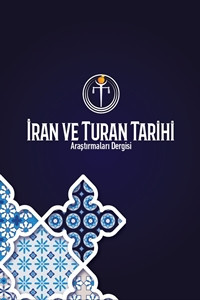ÖZBEK HALK HEKIMLIĞINDE HEKIM MESLEĞI VE SINIFLANDIRILMASI
Özbek halk hekimliği, tıp meslekleri, tıbbi sınıflandırmalar.
MEDICAL PROFESSION AND CLASSIFICATION IN UZBEK FOLK MEDICINE
___
- ABDULLAYEV A., Narodnaya medisina Xorezma, Sovetskoye zdrovoxraniniye. № 5, 1977.
- ABILQASIMOV E., Folk medicine of Kazakh people, Almati, publisher Atamura, 1993.
- ASHIROV A. AND OTHER, Mindon and mindonids, Tashkent, publisher New Release, 2015.
- AXMEDOV R., Historical medicine of Bukhara, Bukhara, publisher University, 2009.
- BASILOV V., “Shamanstvo u narodov Sredney Azii i Kazaxstana, Moskva, publisher Science, 1992.
- BOGDAN RYK, Bukhara surgeons, Turkestansky vedomosti, № 53, 1903.
- BROMLEY YU., Narodnaya meditsina kak predmet etnograficheskix issledovaniy, Sovetskaya etnografiya, № 5, 1976.
- G`OYIBOV M., AND OTHER, Khiva medicine, Tashkent, publisher Abu Ali ibn Sino. 1995.
- GRZYWACZ Z., Traditional Kazakh medicine in change, Poznan, publisher Henryk Jankowski, 2010.
- HANDAYANI L. AND OTHER, Traditional system of medicine in Indonesia, Traditional Medicine in Asia, New Delhi, publisher WHO, 2001.
- HOHMANN S., Ouzbekistan. Instrumentalisation politique de la medecine traditionnelle, Le Courrier des pays de l'Est, № 3, 2008.
- HOMIDIY H., DUSCHONOV B., “Avesto” andmedicine, Tashkent, publisher Ibn Sino, 2001.
- IKROM MAVLON, Water flowing in front, Literature and art of Uzbekistan, № 28, 1984.
- JEAN-FRANCOIS SOBIECKI, The Intersection of Culture and Science in South African Traditional Medicine, Indo-Pacific Journal of Phenomenology. Vol. 14/1, 2014.
- JOVLIYEV A., Development of surgery on the territory of Uzbekistan during the reign of Timur and the Temurids, Family doctor, 21 april 2000 year.
- JURAYEV A., Folk medicine, Tashkent, publisher Orient, 2008.
- KADIROV A., Ob uzbekskoy narodnoy meditsine, Sbornik nauchnix trudov Ministerstvo zdravooxraneniya UzSSR, Tashkentskiy Gosudarstvenniy meditsinskiy institut. Tom XX, Tashkent, 1961.
- KADIROV A., The emergence of Central Asian medicine, Tashkent, publisher Ibn Sino, 1990.
- KADIROVA L., Narodnaya meditsina Sibirskix tatar. Avtoref. diss. k.i.n. Moskva, 2004.
- KUSHELEVSKIY V., Materiali meditsinskoy geografii i sanitarnogo opisaniya Ferganskoy oblasti. Tom I. Noviy Margelan, publisher Lit. Tipograf, 1891.
- LAKOSHCHYN N., Sartarash, Turkestanskiy vedomosti. № 75, 1903.
- LOGOFET D., Buxarskoye xanstvo - pod russkim protektoratom. Tom II, Sanktpeterburg, publisher V. Berezovskiy, 1911.
- MINIBAEVA Z., Folk medicine of the Bashkirs of the Kurgan region (late XIX - early XXI centuries). Abstract of thesis. diss. Ph.D. Ufa, 2011.
- MONAKOV N., Vozmojnost ispolzovaniya sposobov immobilizatsii, primenyayemix narodnoy meditsinoy v Tadjikistane, Izvestiya Akademiya Nauk Tadjikskoy SSR. Otdeleniye yestestven, 1954.
- MUMINOVA G., History of folk medicine, Health, № 1, 1999.
- NAZAROV S. AND OTHER, Abu-l-Qasim Az-Zahrawi -founder of medieval applied surgery, Medical journal of Uzbekistan, № 2-3, 2002.
- OGUDIN V., Attari-aptekari narodnoy medisine musulmanskogo vostoka, Etnograficheskaya obozrenie, № 2, 2001.
- SEYFULMULYUKOV I., K voprosu o tabibizme v Uzbekistane, Meditsinskaya misl Uzbekistana, № 9-10, 1928.
- SMITH E., Practiceof surgery in Islamic lands, Social history of medicine, Vol.13/2, 2000.
- SOBIROV R., Study and use of medicinal plants in traditional Khorezm medicine, Khiva, publisher Khorezm Mamun Academy, 2011.
- SUPRAPTO A., Study on traditional bone healing (research report). Surabaya, 1996.
- SUXAREVA О., Kvartalnaya obshina pozdnefeodalnogo goroda Buxari, Moskva, publisher Science, 1976.
- UROLOV А., Medical organization`s in the past, Tashkent, publisher Science, 1990.
- USMONOV SH., The first healing places, Science and life, № 6, 1998.
- Yayın Aralığı: Yılda 2 Sayı
- Başlangıç: 2018
- Yayıncı: Cihan ORUÇ
BÂBÜRLÜ DEVLETİ’NDE FİLLER VE KULLANIMLARINA DAİR ÖRNEKLER (16.-17. YÜZYILLAR)
TİMUR DEVLETİ’NİN DOĞU POLİTİKASI VE MOĞOLLARLA İLİŞKİLER
HÜSREV GEREDE SİYASİ HATIRALARIM 1 İRAN
ON ALTINCI YÜZYILDA HAYBER GEÇİDİ’NDE BABÜRLÜ KONTROLÜ
XIX. YÜZYILIN İLK YARISINDA HOKAND HANLIĞI’NDA KALEME ALINAN TARİHİ ESERLER
ÖZBEK HALK HEKIMLIĞINDE HEKIM MESLEĞI VE SINIFLANDIRILMASI
İRAN'DA ÇOCUK ŞİİRİNİN TARİHSEL SÜRECİ (سیر شعر کودک در ایران)
